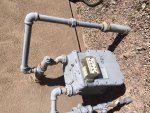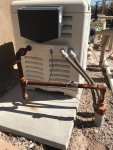- May 23, 2015
- 25,693
- Pool Size
- 16000
- Surface
- Plaster
- Chlorine
- Salt Water Generator
- SWG Type
- Pentair Intellichlor IC-60
I wanted to document this on the forum threads since this issue got diagnosed and solved via PM. First, let me give total credit to our esteemed forum expert @JamesW for helping me to diagnose, test and fix this heater issue. James' help saved me from calling in a "pool service" guy and spending large amounts of cash for what amounted to a $10 fix.
Problem - Heater would fail to ignite after three attempts and "Service Heater" LED would light up. Flipping the top over and there were no service codes at all lit up on the back of the heater input panel. If I shut the heater down and tried again, sometimes it would light up on the 4th try or it would cycle three times again and error out. When the heater would run, the only other issue would be that the stack flue temperature was a little on the low side (280F). So, what to do?
After contacting @JamesW, he had me check a few things that were important. First and foremost was to make sure that the heater was getting enough gas pressure and that it was also utilizing enough gas as well. I got the heater to ignite and let it run for 1 hour while checking the start and stop volumes on my gas service meter. A MasterTemp 400 is a 400,000 BTU/hr heater and so it should use 400 cu. ft of natural gas in one hour. I checked the start and stop volumes on the meter (making sure nothing else in the house was using gas) and, sure enough I used about 425 cu ft or so (this is an older style meter with dial gauges on them so getting an exact start/stop value is a bit tricky). So the heater is using lots of gas.
James also suggested checking the inlet and manifold pressures on the internal regulator of the heater as outlined in the MasterTemp owners manual. I got a differential manometer that reads in inches of water column (" W.C.) but did not have all the tubing and tee's I needed to do all the checks. However, I did have the fittings and tubing to at least check the supply (inlet) pressure. Static pressure with no heater running was 7.8"to 8.2" wc and that would drop down to 4.8" wc on startup but recover to about 5.8" wc. So the static pressure drop of 2" was within spec and the heater needs an inlet pressure between 4" to 14" wc. I did not check the manifold pressure as outlined in the owners manual which should read -0.2" wc if you have your tubing and manometer correctly connected but I assumed that since I had enough volume flow and the pressures were in spec, the manifold pressure was probably ok. I'll eventually check that out of curiosity.
At the same time, James also had me check the flame sensor current on the Fenwal controller which just requires hooking up a True RMS multimeter with DC microamp readout across the FC+ and FC- pins. For a properly functioning flame rectifier, the current should read above 2uA DC. I did that measurement at the same time I measured the pressures and when the heater fired it cycled 2 times and then lit on the third try. Each time it tried to light and failed, the flame current would start at 0uA and struggle to reach 1.0uA. The heater will only wait about 1.5secs for the flame rectifier to read correctly before it shuts down assuming the heater did not ignite. On the third and final attempt, the flame rectifier did jump up past 1.0uA and then held steady above 2uA. So that leads to the issue being with the flame sensor.
As it turns out, this is a known-issue with Pentair heaters (and possibly others) where the flame rectifier has trouble sending out a signal. The reason being is in the details of the circuitry and flame rectification (covered in the links below) but essentially the flame rectifier is sending a DC current from the flame sensor to ground and the Fenwal controller measures that. However, if the connection to ground is poor due to corrosion or loose contacts or age, then the Fenwal can't distinguish between a bad pathway to ground or a failed sensor or a flame that does not ignite. Following James' advice, I installed an extra ground wire as per the Pentair technical bulletin and made sure the contacts were nice and clean. Sure enough, after doing that, the heater ignited on the first try and the current reading between FC+ and FC- started out at around 0.2uA and then jumped immediately over 2uA on ignition and settled solidly into 4.2uA as the heater was running.
Problem solved - bad ground path for the flame sensor.
Here are the links that @JamesW sent me that helped me with the issue -
Heater Flame Sensing - Further Reading
https://www.pentair.com/content/dam/extranet/product-related/product-manuals/pool-and-spa-equipment/mastertemp/MasterTemp_Pool_and_Spa_Heater_Installation_and_Users_Guide_English.pdf
Problem - Heater would fail to ignite after three attempts and "Service Heater" LED would light up. Flipping the top over and there were no service codes at all lit up on the back of the heater input panel. If I shut the heater down and tried again, sometimes it would light up on the 4th try or it would cycle three times again and error out. When the heater would run, the only other issue would be that the stack flue temperature was a little on the low side (280F). So, what to do?
After contacting @JamesW, he had me check a few things that were important. First and foremost was to make sure that the heater was getting enough gas pressure and that it was also utilizing enough gas as well. I got the heater to ignite and let it run for 1 hour while checking the start and stop volumes on my gas service meter. A MasterTemp 400 is a 400,000 BTU/hr heater and so it should use 400 cu. ft of natural gas in one hour. I checked the start and stop volumes on the meter (making sure nothing else in the house was using gas) and, sure enough I used about 425 cu ft or so (this is an older style meter with dial gauges on them so getting an exact start/stop value is a bit tricky). So the heater is using lots of gas.
James also suggested checking the inlet and manifold pressures on the internal regulator of the heater as outlined in the MasterTemp owners manual. I got a differential manometer that reads in inches of water column (" W.C.) but did not have all the tubing and tee's I needed to do all the checks. However, I did have the fittings and tubing to at least check the supply (inlet) pressure. Static pressure with no heater running was 7.8"to 8.2" wc and that would drop down to 4.8" wc on startup but recover to about 5.8" wc. So the static pressure drop of 2" was within spec and the heater needs an inlet pressure between 4" to 14" wc. I did not check the manifold pressure as outlined in the owners manual which should read -0.2" wc if you have your tubing and manometer correctly connected but I assumed that since I had enough volume flow and the pressures were in spec, the manifold pressure was probably ok. I'll eventually check that out of curiosity.
At the same time, James also had me check the flame sensor current on the Fenwal controller which just requires hooking up a True RMS multimeter with DC microamp readout across the FC+ and FC- pins. For a properly functioning flame rectifier, the current should read above 2uA DC. I did that measurement at the same time I measured the pressures and when the heater fired it cycled 2 times and then lit on the third try. Each time it tried to light and failed, the flame current would start at 0uA and struggle to reach 1.0uA. The heater will only wait about 1.5secs for the flame rectifier to read correctly before it shuts down assuming the heater did not ignite. On the third and final attempt, the flame rectifier did jump up past 1.0uA and then held steady above 2uA. So that leads to the issue being with the flame sensor.
As it turns out, this is a known-issue with Pentair heaters (and possibly others) where the flame rectifier has trouble sending out a signal. The reason being is in the details of the circuitry and flame rectification (covered in the links below) but essentially the flame rectifier is sending a DC current from the flame sensor to ground and the Fenwal controller measures that. However, if the connection to ground is poor due to corrosion or loose contacts or age, then the Fenwal can't distinguish between a bad pathway to ground or a failed sensor or a flame that does not ignite. Following James' advice, I installed an extra ground wire as per the Pentair technical bulletin and made sure the contacts were nice and clean. Sure enough, after doing that, the heater ignited on the first try and the current reading between FC+ and FC- started out at around 0.2uA and then jumped immediately over 2uA on ignition and settled solidly into 4.2uA as the heater was running.
Problem solved - bad ground path for the flame sensor.
Here are the links that @JamesW sent me that helped me with the issue -
Heater Flame Sensing - Further Reading
https://www.pentair.com/content/dam/extranet/product-related/product-manuals/pool-and-spa-equipment/mastertemp/MasterTemp_Pool_and_Spa_Heater_Installation_and_Users_Guide_English.pdf
Last edited:



